As an Amazon Associate I earn from qualifying purchases.
Brining olives is the oldest way to cure olives, especially green ones. What follows are instructions and troubleshooting on how to cure olives with a brine. There are other ways I’ll get to below.
This post assumes you have access to fresh, green olives off the tree, which are pretty but inedible — they are impossibly astringent. Olive trees can be found all over California, in many parts of Arizona, as well as Australia and, obviously, the Mediterranean, where they are native.
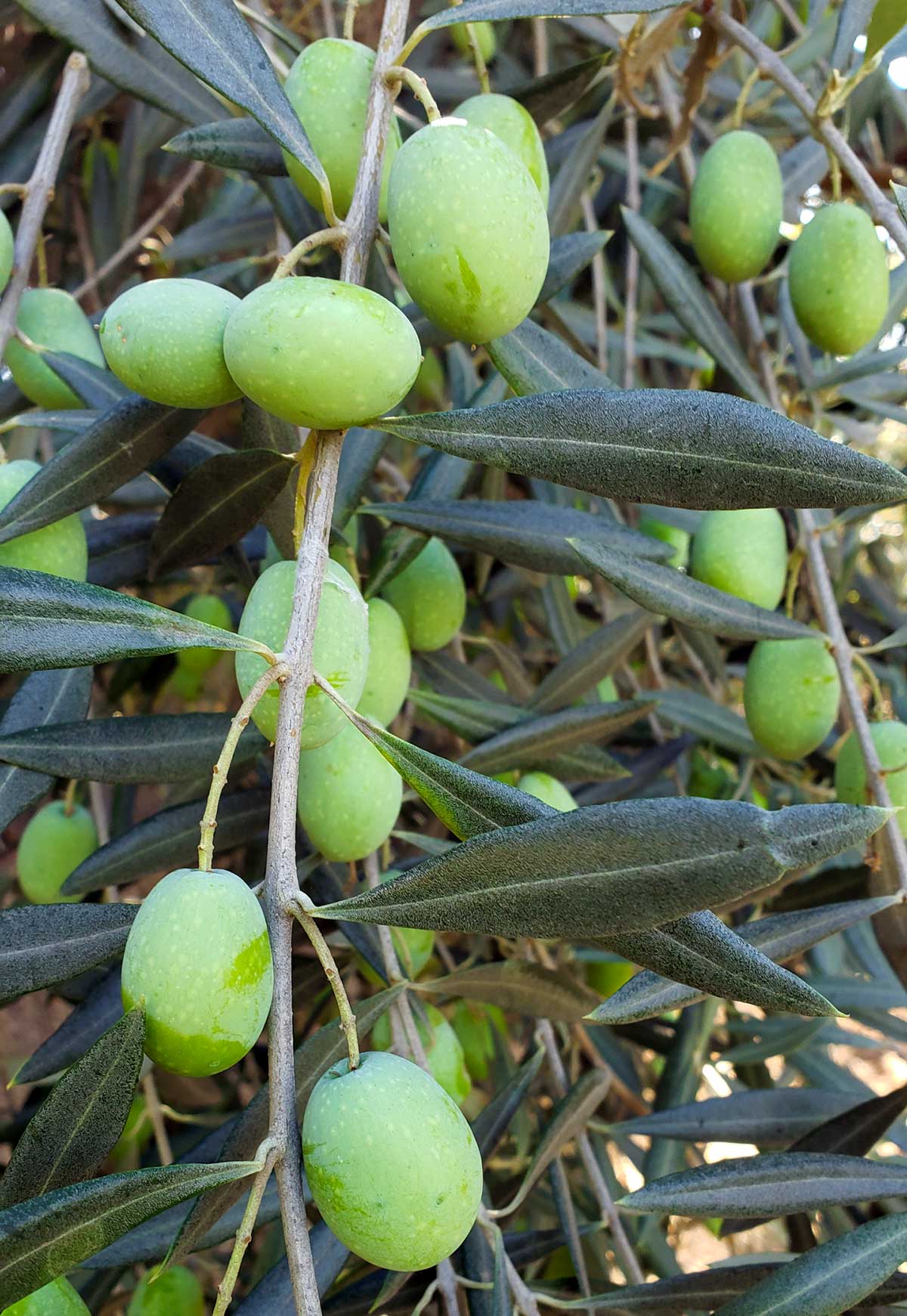
You can buy fresh olives online, and over the years I have provided links, but these companies seem to come and go quickly, so I don’t do that anymore. Just Google “buy fresh olives” around September here in the United States, and I think March in Australia.
The timing is important because you want fresh green olives. And yes, like peppers, all olives start green and ripen to another color, usually black in the case of olives.
Green, unripe olives are firmer and way more astringent than ripe ones. Brining olives when they are green is a great way to cure them, and green olives are the only olives suitable for what, admittedly, is my favorite cure, which a lye cured olive. That process, believe it or not, has been used for 2000 years, and is not as scary as it sounds.
You can brine ripe, black olives, too, just so you know.
My general rhythm is to cruise my local parks in late September or early October; they are full of olive trees, remnants of pre-suburbia orchards around here. On some crisp autumn Saturday, I go picking. Look for pretty olives, with few or no blemishes, and which are not wrinkled.
Tiny dots on an olive are OK, but many may be rotten with olive fly, whose larvae burrow into olives and leave a beige scar where they entered. that telltale scar means there is a visitor lurking within your olive.
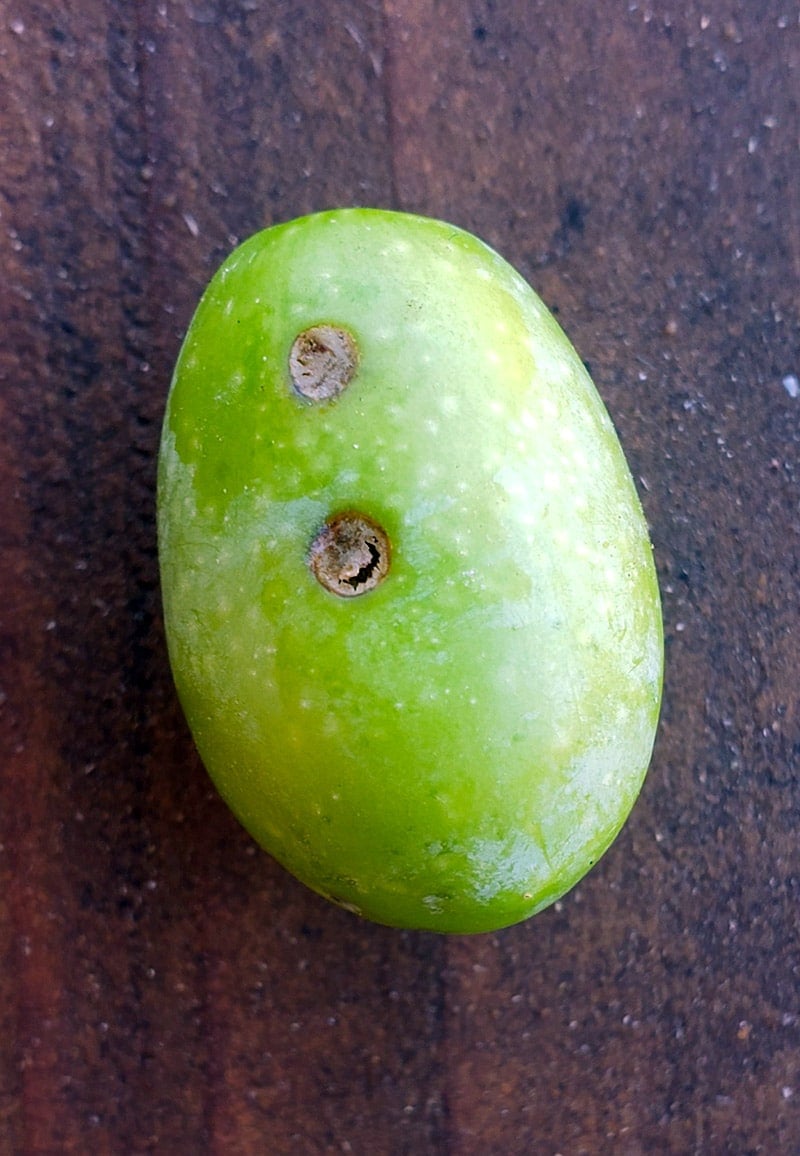
Another hazard are the dry olives. Trees forced to live by their own wits — away from regularly watered grass — are stressed, and their olives shrivel early. Shriveled olives are usable, but they bruise rapidly and don’t make a clean green olive.
When you get home, separate your olives into small, medium and large olives — it doesn’t matter what variety they are, as I don’t know how to tell the difference. If you don’t have enough large ones to make its own batch, mix them with the mediums.
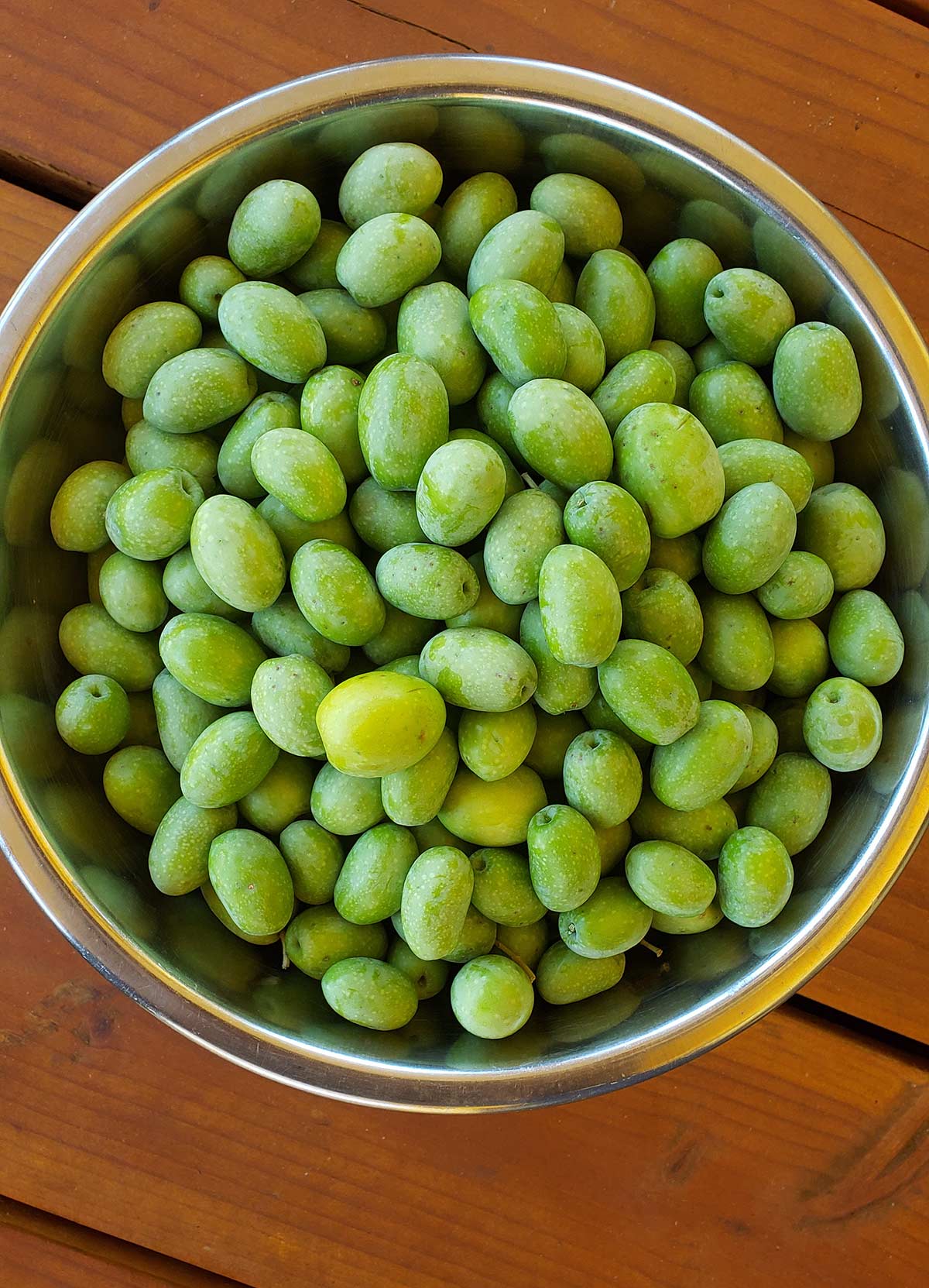
Unless I am doing the lye cure, brining olives is my preferred method, as it is low-maintenance and results in a super-tangy, salty olive that keeps for more than a year and cries out for beer or ouzo. And I like ouzo. A lot.
Brine-curing is easy, but takes a long time. You make a brine of 1/4 cup kosher salt (I use Diamond Crystal) to 4 cups water, plus 1/2 cup of vinegar: white wine, cider or simple white vinegar. Submerge the olives in this brine and top with cheesecloth or something else to keep them underwater. Do not cut them.
Cover the top of the container loosely (I use large, 1 gallon glass jars) and put the jar in a dark, cool place. That’s it. Check it from time to time — meaning every week or so at first. The brine should darken, and you might get a scum on the top. That’s OK.
What’s going on is that your olives are fermenting; it is the fermentation that breaks down the oleuropein over time. The what? Yeah, oleuropein is the astringent substance in an unripe olive. It needs to go if you are going to eat one. Fermentation is why I never wash my olives before curing — I want those natural yeasts on the outside of the olive to do their magic.
I change my brine every month or two, when it begins to look extra nasty. I don’t re-rinse the olives, during changes, either, because I want the residue to act as a “starter” to get the next batch of brine going.
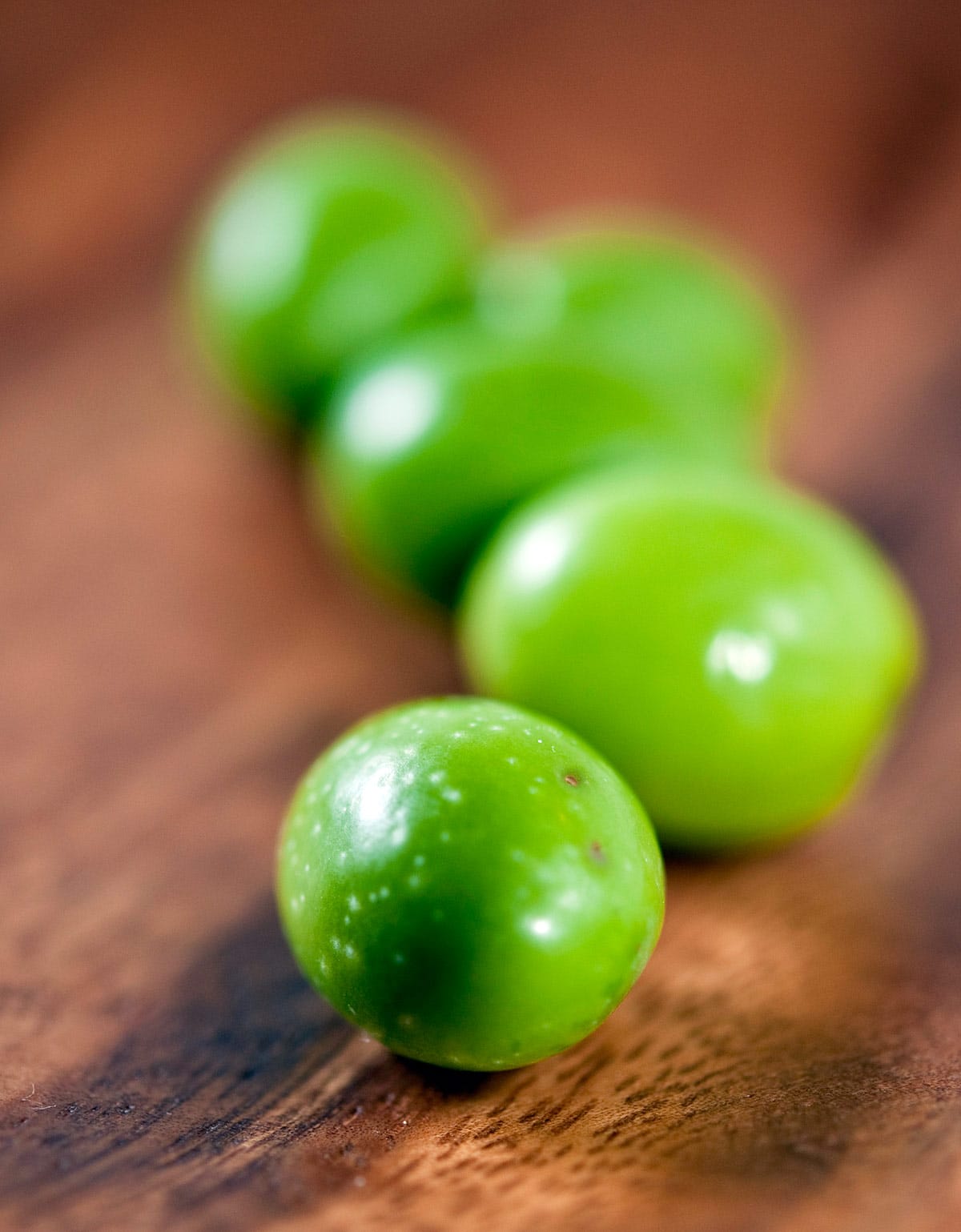
Keep in mind you will be in for the long haul: Olives picked in October are typically ready to eat in May or June. It’s a lot like making wine.
Add seasonings after the New Year, or even later, otherwise you risk too much spice and not enough olive flavor; this is especially true of chiles. If you find you’ve gone too far, change the brine and don’t add new seasonings, and let it steep for a few weeks. That should calm things down a bit.
Once the olives are finished, there is a certain show-off factor when you pull out a plate of olives you cured yourself. “These are your olives? Wow.” Plus, you can flavor them any way you like, which is a bonus.
If you’re too late for green olives, I really like salt cured black olives, which we all call oil-cured olives since that’s how they are stored. If you want to cure black olives, my method is to oil-cure olives.
Brine Cured Green Olives
Ingredients
- 4 pounds fresh green olives
- 1 cup kosher salt
- 1 gallon water
- 1 cup distilled vinegar
Instructions
- Assuming you've already checked your olives for worm scars (see headnotes), discard any with too many blemishes. Place the olives in a stoneware crock or large glass jar with a lid carefully. Fresh olives actually do bruise easily.
- Mix the vinegar, salt and water together. No need to boil, as it will dissolve at room temperature. Pour this over the olives, making sure they are submerged by at least 2 inches. Add more brine in the same ratio if need be.
- Chances are the olives will float. You need to keep them away from air, so I put a plate over them that is just about the size of the jar or crock. You can also use a plastic bag filled with water to keep the olives away from air. Once the olives are submerged, cover the jar or lid (lightly screw on the top if there is one) and place the container in a cool, dark place. A basement is ideal. You don't want them to ever get beyond 75°F if you can help it, because at higher temperatures the olives can go soft. Since this is a wintertime cure, it should not be a problem. Low temperatures are fine, just don't let them freeze. Let them sit for several months.
- As time passes, you will see a scum of mold and weirdness form on the top. This is normal. Skim it off once a week and you'll be fine. At some point the brine itself will get pretty icky. I like to change the brine every month or so, but this is not strictly needed. The olives are done when they are no longer bitter, anywhere from 2 to 4 months.
- Only now do you add other seasonings, like chile peppers, black peppercorns, herbs or citrus peel. Do this in a fresh brine, and let this new, flavorful brine sit 2 weeks before serving. Store the olives in this brine, in a cool place or refrigerator, for up to 2 years. I keep them in quart Mason jars.
Notes
Flavor Additions
- dried chiles
- bay leaves or similar aromatic leaves like citrus leaves
- thyme, sage, oregano, rosemary
- allspice, black peppercorns, juniper berries
- smashed garlic cloves
Nutrition
Nutrition information is automatically calculated, so should only be used as an approximation.

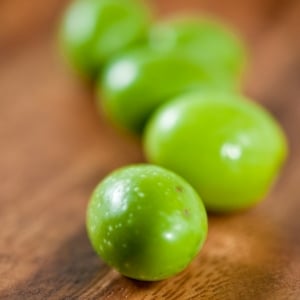




Tina: Not sure exactly why some olives get slimy, but I am definitely sure you should toss them; I think it’s some sort of fungal thing. I’ve only tossed those that are slimy, then changed the brine/water and kept the rest.
Hank – I have the same question as Jack. Why are some olives slimy? And do you throw the whole batch out when a few are slimy?
Thanks,
Tina
Hank…this is so weird! A few nights ago I had dreamed of curing green olives, an annual undertaking of my Italian family, with us kids smacking the olives with clean milk bottles so they split neatly and were ready for soaking. I dreamed and woke intermittently, each time going back to the dream again and again, and getting bits and pieces of the process but not enough to proceed, except for some of the ingredients like garlic and celery. I had gone to our local produce/gourmet store the day after my dreams and found the green olives!
Since my oldest brother’s passing a few weeks ago, I had no one to ask, but decided today to do a search on the internet and found you! Thank you, thank you, thank you!!! I now know that 3 days, which I had thought, was not enough to soak, and some other things I had forgotten. I appreciate the information so much… a true remembrance of things past.
Hey Jaime: I’ve stored olives in brine at room temperature for a year. BUT, your room temp is really, really hot. 85 degrees?! Put ’em in the fridge. Mine stay just under 70 degrees in a cool spot.
Hi there-
I was wondering how long I can STORE the olives at room temperature (80-85 F) after I’ve gotten them the flavor I want and while they are in a Salt Brine.
Does Anyone know?
Thanks. Jaime.
Alex: Yes, it’s OK to add spices and garlic to the brine — make sure you do it late in the process, though. If you are doing the all-brine cure, don’t add anything but salt until after New Year’s. If you are doing the water cure and want to spice up the brine you store the olives in, go ahead — it’ll be in the fridge, anyway.
Hi Hank,
Is it OK to add fresh garlic, along with the spices, during the brining process or will the garlic go bad?
Thanks, Hank.
Just in time, too. Half the olive trees around here already have different stages of ripe fruit while many others have large, green fruit. Now I have a chance to try both techniques on different stages of fruit – time to go harvest 🙂
John: Nope. Don’t break the olives in the brine cure. It just takes time for the bitterness to seep out. Salt will do the trick all by itself.
Tiny: I wouldn’t do it. Toilet water is technically drinkable, but the inside of most people’s toilets is coated with slime and mineral deposits. Plus, it would definitely stain the potty. Get a really big glass jar instead.
Could you maybe do the water soaking part by putting them in a plastic mesh bag ( (like for onions) and putting them in the toilet tank? I ‘ve heard of leeching acorns that way.. why not olives? Would it stain the potty?
Thanks for the inspiration Hank!
I live in SE Arizona, where olive trees are abundant – one of the desert dwellers that does well here. Most people here find them a nuisance, and so the fruiting branches get cut away and tossed. I, on the other hand, have always thought this was a horrible waste but could never find anyone who knew the process of making them edible.
I’m very interested in your brine technique. From time to time, I make my own cheeses, so the added time is not a concern – somehow, the wait makes the finished product that much more enjoyable. I was curious, however, if you also need to break, or slice, the olives before placing them in the brine, as you did for the water cure? It would seem to make sense that you would still want to leach the bitter properties from them in this manner, but then I don’t know if salt is somehow a conduit to this process on it’s own.
I look forward to your reply – and really, thanks – you don’t know how long I’ve been waiting for this. I should’ve “Googled” it a long time ago!
Olga: Yes, I changed the soak times for the water cure because I’d not had good luck with the shorter times everyone seems to recommend. These olives, with the new soak times, were WAY better.
Hello Hank,
Your blog was the first I have found with really useful information on olives, which is what I was searching for when I found it but I have learned so much from all you have to say.
My question is about olives, we have 8 trees that are about 12 years old, they are fabulous to look at and very good producers, all organic and no pests. Last year my mother and husband decided to cure some of them, with very mixed results…ok, they stink. I shudder to even look at them.
I lived for many years as a teen in Greece with my family and I was the one who had the job of smashing the olives with a brick to break them so my aunt could cure them. That and the harvesting was pretty much my only exposure to the process but having come from a culinary family I have good palate and knew from observing that they were making a few mistakes.
My mother had met an old Italian gentleman who lives down the street and he “taught” them and I deferred to him. I am sorry we did because the results were not what I think they should have been.
I noticed that you revised the time frames you used to cure your olives, do you feel that your revised time frames worked well this year?
Thanks so much for your great article and I hope they keep coming!
Thank you so much for this post! Back in August, I wanted to brine my own olives. I was looking around on the internet for resources on how to do it, and I was so overwhelmed because it just seemed like a random hodgepodge of information and nothing concise and complete. This has really made my day. I am so excited to be able to do this this year.
Boy howdy! I’ve been looking for this advice. Me and the hubby just planted an olive tree. We can’t wait to cure them (in a few years, of course). 🙂 Thanks for the as-always, excellent advice.
Hank, I live in Northern CA and travel to Italy fairly often on business. I was a guest at a home in Italy where I was fed some Olives before dinner that the family cured themselves. I do have a few olive trees at my home so this peeked my curiosity and asked for the Recipe. We enjoy the harvest event in October just like you describe, only I am on the ladder and my wife is below drinking the wine, I do get to watch Cal Football (Go Bears!) after, so all is good.
The recipe I was given was almost identical to what you have written with the exception of white wine vinegar, I’ll try that next year.
My first year curing was last year, some Olives developed a slimy coating with a bad taste, I threw the whole batch out because you never knew when you would get one. Have you had this experience before?
I am in my second year curing now with the same recipe and so far they are tasting great, 30 days left. My second question is, after curing, how do you store the olives? Do you use the same brine solution and after filling the jar with olives, do you use the same brine solution in the jar? I am almost to the point of removing from the brine and herb solution, what’s next? I didn’t think far enough ahead to ask them that, plus my Italian is not great. : )
Thanks a bunch, Hank. I suspected that 1:2 might be a bit much vinegar. Do you know what is a good Ph level to maintain in stored olives? Should I test Ph level? If so, what kind of device would you recommend?
Linda: That happens to mine, too. Change the brine and add some vinegar.
Bob: That is a LOT of vinegar! No botulism in that batch… I usually go with 1/2 to 1 cup of vinegar to a quart of briny water. Botulism needs a non-acid environment, and an anerobic one, so with that much vinegar and air circulating you will get mold (which I find to be normal) but no botulism — at least in my experience.
I am preparing home-cured olives (black & green) for the first time, curing them in brine, then replacing the brine with solution of 1:2 parts vinegar and water (adding garlic, chili, fennel or thyme). I am concerned about botulism, as the jars I am using are not air tight. Advice on this question would be greatly appreciated, as so far I have not found the question addressed anywhere on line.
Hi Hank
The olive brine is developing a white clumpy residue throughout the jar -concentrated at the top and bottom. Is this just fermentation or is it a bad residue?
Thanks